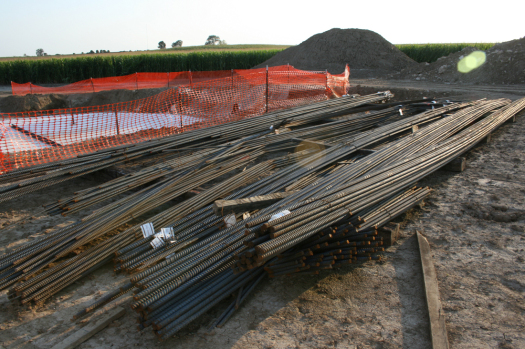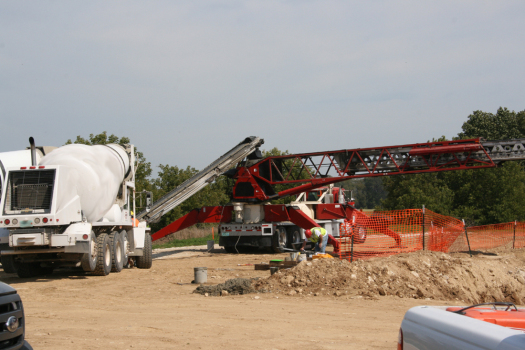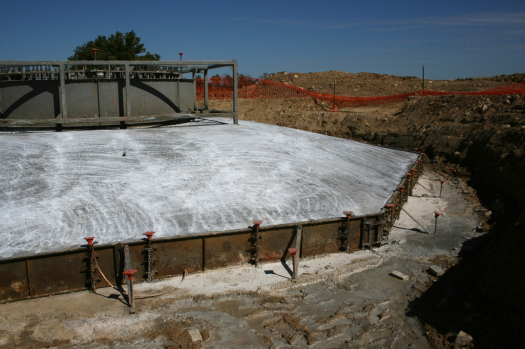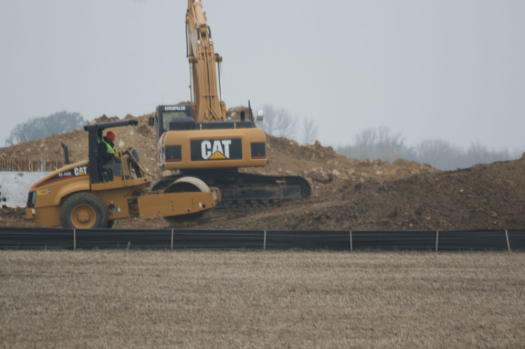2/27/08 U is for Unsafe: How the state of Wisconsin failed to protect the people of Byron
U is for Unsafe: How the State of Wisconsin failed to protect the people of Byron Township
 December 2008. Town of Byron, Fond du Lac County, Wisconsin. Photo by wind farm resident, Gerry Meyer.
December 2008. Town of Byron, Fond du Lac County, Wisconsin. Photo by wind farm resident, Gerry Meyer.
What are we hearing from the wind farm in the town of Town of Byron?
We hear complaints about turbine noise, vibration, sleeplessness, headaches, nausea, and ringing in the ears.
We hear about shadow flicker so severe it's impossible to stay in the same room.
We hear of no access to emergency medical helicopters because Flight for Life can't land in many parts of the wind farm.
Most of all we are hearing that no one at the Public Service Commission seems to be listening, much less doing anything to help.
The Public Service Commission approved that project. It approved setbacks and noise limits from residences based on no scientific or medical data. Setbacks and noise limits that are causing problems for a lot of families right now.
We are hearing loud and clear from the people of Byron that the turbine siting approved by the state is causing serious problems. We are hearing that people are suffering and something has to be done about it.
Winter 2008 Fond du Lac County. Photo by Gerry Meyer
What are we hearing from Madison? That there's a bill about to be introduced that would make the whole state open to the same turbine siting disaster people in the town of Byron are now forced to live with.
Wind Farm Bill Would Govern State
Paul Snyder
24 February 2009
State Sen. Jeff Plale says he is weeks away from introducing a new bill establishing statewide guidelines for wind farm development.
But meshing existing municipal ordinances into one that would govern the state has some bracing for a fight.
“When you jump into something really quick, as Wisconsin did with ethanol, you end up seeing some bad results,” said Magnolia Town Supervisor David Olsen. “I hope they don’t try to just push things through. (Legislators) should be there to represent constituents, not lobbyists.”
Although Plale, D-South Milwaukee, conceded his attempt to get a statewide wind farm siting bill passed at the end of the last session was late-developing and criticisms that it was rushed were justified, he said he likes his chances this time around.
“We’re trying to build a broad-based coalition with a lot of stakeholders,” he said. “I think understanding of wind power is better than last time, and so is the general prognosis.”
State law gives the Public Service Commission of Wisconsin the right to approve any wind farm that would produce more than 100 megawatts of energy, while any wind farm producing less than that amount can be decided upon by local municipalities. Plale said the goal is to give the state the final word on any development, regardless of its output.
But Plale declined to give any details about the bill in terms of possible setback distances or whether county or municipal governments that already have ordinances in place would be grandfathered in. He said details are still under negotiation, but suggested local ordinances might not set the best parameters for state law.
“If we’re going to make renewables a priority in this state,” he said, “we can’t have one community dictating policy for everyone else.”
Wisconsin instituted a mandate of producing 25 percent of its energy from renewable resources by 2025.
Magnolia, which enacted its own ordinance earlier this year requiring half-mile setbacks for turbines from homes and businesses, would be a good example to follow, Olsen said.
“Just for sound and flicker-flash purposes,” he said, “I think it’s very fair.”
Yet wind farm developers looking to build in locales with such ordinances remain hamstrung by the terms and argue such setbacks leave no viable land on which to build multiple turbines.
Legal battles already surfaced in response to Trempeleau County’s one-mile setback ordinance, and last week Hubertus-based Emerging Energies LLP filed a complaint against the Manitowoc County Board of Adjustment’s ruling against the company’s request for a conditional-use permit to build a seven-turbine wind farm.
Edward Ritger, the attorney representing Emerging Energies, did not return repeated calls for comment.
But County Executive Bob Ziegelbauer said the complaint is just the latest step in a legal battle stretching back to when the county first adopted its ordinance in 2004.
“Frankly, our expectation was that whoever would not have received the favorable judgment would have gone that route,” he said.
Ziegelbauer, who also serves as a Democratic representative in the state Assembly, added there is still strong local opposition in Manitowoc to a statewide wind farm ordinance.
“We, as a state, pay homage to the concept of local control, so it’s kind of insulting to a community that agonizes for years to put an ordinance together to come sweeping in with a state ordinance because you believe you know better,” he said. “I say this tongue-in-cheek because of the homage we pay to people in (the capital), but please let us make our own decision, even if we’re a little slow sometimes.”
Even if the coalition for state wind farm guidelines strengthened in the last year, Olsen said the coalition against the state did too.
“If anything, it’s probably the exact opposite of what (Plale) says it is,” he said. “I agree there’s a lot more information out on wind farms now, but I’d say with that, there’s even more of a push for local control.”
A NOTE FROM THE BPWI RESEARCH NERD: Why not contact your legislators and let them know that the turbine the state wants us to live 1000 feet from is ten stories taller than the Capitol dome. Ask them how close would they allow a forty story turbine with a spinning blade span wider than a 747 -- how close to the capitol dome should it be?


ANOTHER NOTE FROM THE BPWI RESEARCH NERD:
 We were glad to see Magnolia Town Board Supervisor, Dave Olsen, quoted in the article above. Dave Olsen is an elected official who actually did listen. Magnolia was the first township in Rock County to adopt an ordinance which gives residents the kind of protection the people in the town of Byron do not have.
We were glad to see Magnolia Town Board Supervisor, Dave Olsen, quoted in the article above. Dave Olsen is an elected official who actually did listen. Magnolia was the first township in Rock County to adopt an ordinance which gives residents the kind of protection the people in the town of Byron do not have.
We were also glad to hear Dave Olsen is running again.
Better Plan proudly endorses Dave Olsen for Town Supervisor!
Remember: Voting day in Magnolia is April 7th! Mark your calendars!
Use your vote to help keep Magnolia safe and strong!
1/26/09 T is for Turbine: The visual anatomy of a 400 foot industrial machine from the ground up.
 This week we'll be continuing our look at the anatomy of an industrial wind turbine, focussing on the visible parts of the turbine. They are the nacelle, which houses the machinery of the turbine, the blade assembly, or rotor, which is located at the hub of the turbine, and the tower it all rests upon.
This week we'll be continuing our look at the anatomy of an industrial wind turbine, focussing on the visible parts of the turbine. They are the nacelle, which houses the machinery of the turbine, the blade assembly, or rotor, which is located at the hub of the turbine, and the tower it all rests upon.
The above-ground parts of an industrial scale turbine can measure from 400 feet to 500 feet - or forty to fifty stories stories tall -from ground to blade tip.
(Photo above taken by Town of Union Study Committee member, Jim Bembinster, Fond du Lac County, Wisconsin, 2008)
The towers can weigh between 150 to 225 tons and are typically transported in three sections, each approximately 80 feet long.
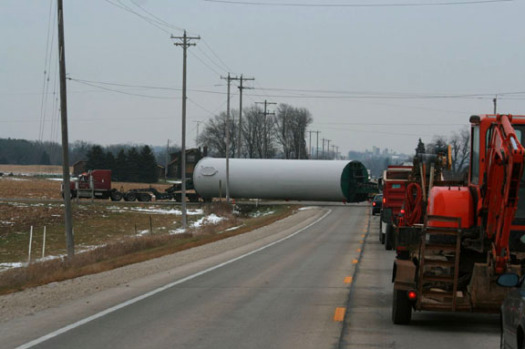
(Unless otherwise noted, all other photos in this post were taken by wind farm resident, Gerry Meyer, near the town of Byron in Fond du Lac County, Wisconsin, Winter of 2007-08)

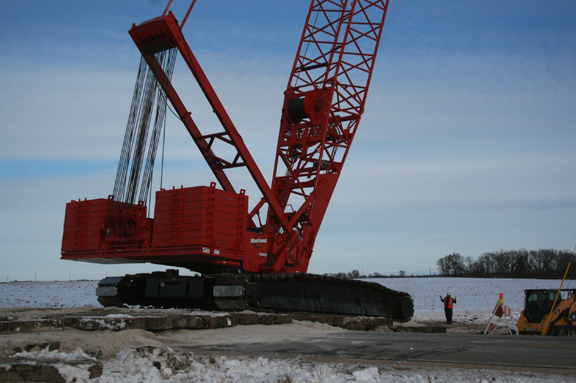
The cranes required to assemble the turbines can weigh 300 tons and also require several over-size loads to transport them to the site.

The first section of the tower has been set. If you look closely you'll see two men at its base.
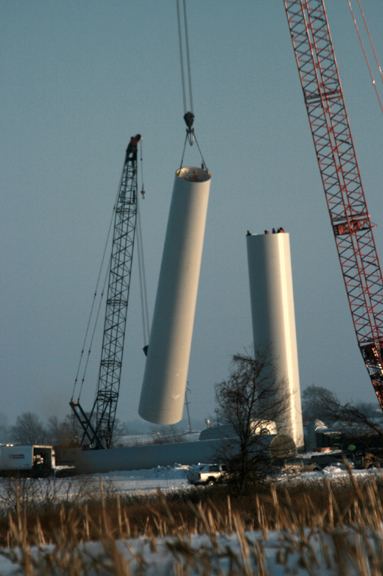
Workers are visible at the top of the first section.
Turbine constuction work continued into the night near the town of Byron in Fond du Lac County.
We'll be adding additional photos of the blades and the rotor in upcoming days.
The turbines in Byron have blades that are 130 feet long each. Newer turbines are getting larger and larger. Here is a description of the new 15 ton turbine blades being transported from Brazil which appeared in a news article today. [Click here for source]
"Each blade is 154 feet long, weights about 30,000 pounds, and they come to the site fully assembled on the back of a tractor-trailer. That isn’t the only thing needed to put together these enormous turbines. The amount of equipment needed to put a turbine together is massive."
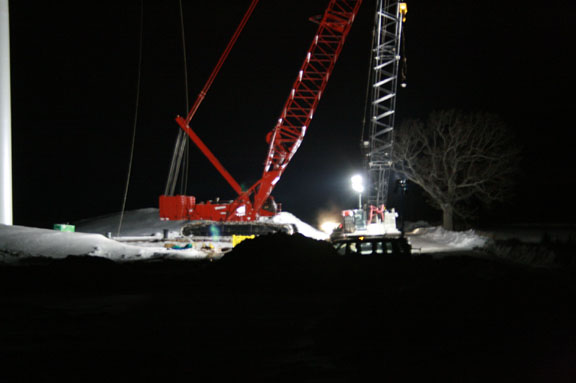
The blade assembly, or rotor, can weigh anywhere from 35 to 45 tons. The bladespan on this turbine is wider than a 747 jet. The newest big turbines have a blade span as wide as a football field.
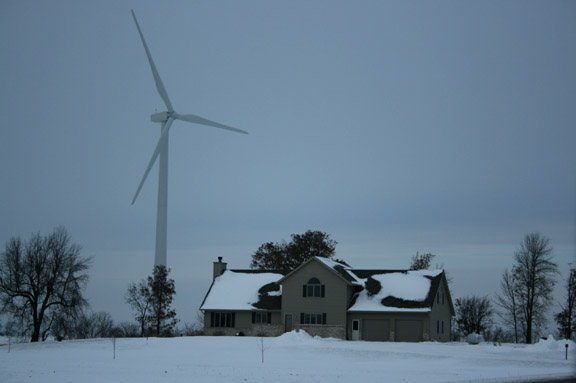
After the construction noise is done with, and the turbines go on line, a new kind of noise cuts through the Fond du Lac County nights, keeping residents awake and angry. It's the noise wind developers said would not be there. But the developers are gone. And the noise is here to stay.

2/22/09 T is for Turbine: What goes up sometimes crashes to the ground.
UPDATES: LATEST WIND TURBINE ACCIDENT : 3/6/09: Click here to read "Wind turbine collapses in Altona"
T is for Turbine: What goes up sometimes crashes to the ground.
February 22, 2009
Over the week-end, two Iowa families were asked to evacuate their homes when an industrial wind turbine began spinning out control due to a 'catastrophic error' made during construction. A third family was contacted as well, but were not home at the time.[1]
There was no way to stop the turbine blades, which continued to spin wildly throughout the night until the blade assembly and 50 ton nacelle broke away from the tower, fell from a height of -246 feet--nearly 25 stories-- and crashed into the ground.
[Click here to watch a news report about this story]
No one was hurt.
In the video below, the general manager for this project says no property should be closer than 400 meters (about 1300 feet) from the turbines. She said for this project there are no homes closer than 600 meters (about 2000 feet) from the turbines.
What is the setback in Wisconsin?
1000 feet from a home.
That is, unless you sign-on with the wind developer. In that case you can have a turbine as close as 440 feet to your door.
[Click on the image below to watch an interview with the project manager about the accident]
There appears to be no available footage of the Iowa turbine breaking apart, but a nearly identical accident happened last winter in Denmark when the turbine brakes failed during a wind storm. This slow motion video shows how far the blades were thrown and what it looked like when the 50 ton nacelle hit the ground.
[Click here to watch another news story about the Iowa accident]
2/19/09 T is for Turbine: The Anatomy Industrial Scale Wind Turbines: Below Ground Level
T is for Turbine: The anatomy of a 400 foot tall industrial machine: Below Ground Level

 Below ground is the footing or foundation for the turbine.
Below ground is the footing or foundation for the turbine.
The turbine tower will be anchored to a foundation consisting of more than one thousand tons of steel rebar and concrete.
The foundation's depths can vary from six feet to thirty feet, depending on the composition of the land, and can be forty to fifty feet wide.
This platform will support the steel towers which weigh between 140 to 225 tons- depending on their height, nacelles that weigh between 50 and 70 tons, and the rotor or blade assembly which weighs between 35 and 50 tons, for a total weight of 200 to 345 tons. [1] [2] [3]
Developers will rarely agree to remove all of the foundation when the turbines re decomissioned. Most will not remove more than four feet of below-ground concrete and rebar, and only if this was agreed to prior to construction or is required in a town or county ordinance.
Each turbine requires high voltage electrical cables trenched into the ground and connected to a substation and then the electrical grid. The turbine will use these high voltage connections to draw power in order to operate the machinery and also to send power when there is sufficient wind.
Each wind turbine also requires its own access road. These roads will vary in length and location across a landowner's property depending on the wind developer's needs and wishes unless the landowner makes sure the preferred location of the turbine, the road, and the trenches are spelled out clearly in the contract.
The photos below show the first steps of the turbine construction phase. (Unless otherwise noted, all construction photos by Gerry Meyer, Fond du Lac County, WI, 2007 and 2008)
 Above: Landowner's field being prepared for turbine construction
Above: Landowner's field being prepared for turbine construction






Industrial scale wind turbines require high voltage cables to be trenched into the soil. These cables appear to be laid in without conduit.

Below: Gravel access road and high voltage electrical cable trench cut diagonally through landowner's field.

In the right-hand corner of the image above, you can see the substation where good crop land used to be.



Landowners should expect the inevitable damage to their fields from the size and weight of the machinery required for industrial wind turbine construction. Torn up fields, severely compacted soil and careless removal and treatment of topsoil are frequent complaints from landowners hosting turbines. How the land will be restored and how a landowner will be compensated for this kind of damage is another thing which must be clearly addressed in the contract.






NOTE FROM THE BPWI RESEARCH NERD--We thank Gerry Meyer for sharing these construction photos with us. Next, turbine anatomy from the ground, up.
1/14/08 S is for Setbacks: Why 1000 feet is just too close.
S is for Setbacks: Why 1000 feet from your door is just too close.
"The closer people live to wind turbines, the more likely they will experience noise annoyance or develop adverse health effects from wind turbine noise"
-Town of Union Large Wind Ordinance (p. 10, 4.)
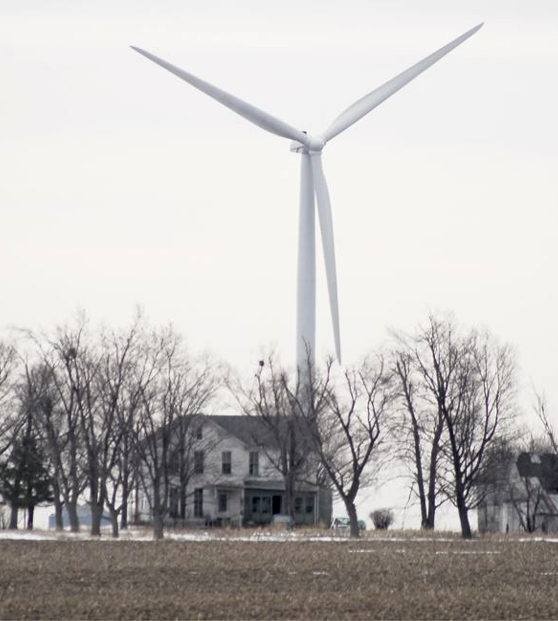 Home in a PSC approved wind-farm in Fond du Lac County, winter, 2008. Photo by Town of Union Study Committee member, Jim Bembinster.
Home in a PSC approved wind-farm in Fond du Lac County, winter, 2008. Photo by Town of Union Study Committee member, Jim Bembinster.
Unless your township has a large wind ordinance, the state of Wisconsin allows turbines to be sited just 1000 feet from your home, or as close as 440 feet if you give your permission to the wind developer.
These setbacks insure profitability for the wind developer, but do little to protect the health and safety of residents who now find themselves living in the shadows of wind turbines sited much too close to their homes.
Where did the state's 1000 foot setback come from?
Even Vestas, one of the largest manufactures of wind turbines, advises its workers and operators to stay at least 1300 feet away from a turbine unless absolutely necessary. [Source: Vestas workers and operators manual. Download it by clicking here]
The town of Union researched the origin of the state's 1000 setback and found it was based on no scientific or medical data at all, but rather the recommendations of wind developers and lobbyists. The state could not provide the Union study committee with a single document used to support the safety of the 1000 foot setback.
As evidence of health problems associated with poorly sited wind turbines is growing by the day, (along with evidence of unexpected wildlife impacts), Wisconsin townships and county governments are working hard to adopt ordinances which will protect their community.
At this moment, wind developers and their paid lobbyists (like Michael Vickerman of RENEW Wisconsin) are urging our legislators to disregard this evidence, override local ordinances intended to protect health and safety, and fast-track legislation that will make the state's inadequate setback distances and noise limits mandatory for all of Wisconsin.
 House and Four Turbines, Fond du Lac County, Wisconsin, December 2008
House and Four Turbines, Fond du Lac County, Wisconsin, December 2008
Let's look at what the town of Union ordinance says about setbacks.
(Download the entire ordinance by clicking here)
The definitions section of the ordinance (page 11) helps us understand some of the terms used in relation to Wind Turbine siting and setbacks.
These include:
Sensitive Receptor: Places and structures intended for human habitation whether inhabited or not. This includes homes, schools, churches, hospitals, elder care facilities and non-agricultural businesses and places like public parks, state and federal wildlife areas, certain recreational areas designed for public use, like campgrounds, golf courses, and other non-agricultural state of federal licensed businesses.
These areas are more likely to be sensitive to the exposure of the noise, vibration, shadow flicker, and other disturbances generated by industrial-scale wind turbines. (p.16,(ff)
Distance Attenuation: The reduction (attenuation) of sound by increased distance from the source of the sound. In other words, sound power weakens over distance and does so in a variable way, depending on the source of the sound.
Point Source: Sound which spreads from its source spherically in all directions. Every time you double the distance from a Point Source of sound, the noise level decreases by 6 dB.
Line Source: Sound which spreads cylindrically from its source, like the sound of made by a stream of cars on a busy road. Every time you double the distance from a Line Source of sound, the noise level decreases by 3 dB. (p.13,(j)
The findings regarding wind turbine setbacks begin on page eight of the ordinance.
The Town of Union finds:
Minimum setbacks from dwellings are necessary to mitigate, (reduce) wind turbine noise impacts not predicted with sound models.
Pre-construction sound models don't accurately predict impacts from turbine noise because they don't consider factors that can affect the way sound travels, such as atmospheric conditions, temperature inversions, wind layers, geography and low frequency noise which travels further with less loss of intensity than higher frequency noise.
At night, when air stabilizes, wind turbine noise can travel farther than expected and be 5 to 15 dB louder than predicted. [Kamperman and James 2008] (p.8,1.)
A dBC scale for measurement of sound is required to minimize adverse health effects from low frequency sound. A dBC requirement will likely result in setbacks of 3280 feet (1 kilometer) or greater for 1.5 to 3 MW wind turbines if the turbines are located in quieter rural areas where the background levels are 30dBA or lower. (p.9, 2.)
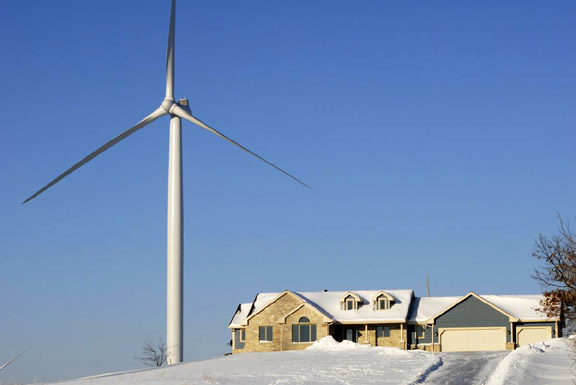 Fond du Lac County, winter 2008. Photo by Union Study Committee member, Jim Bembinster
Fond du Lac County, winter 2008. Photo by Union Study Committee member, Jim Bembinster
Noise diminishes with distance. According to a sound propagation formula from the University of Massachusetts Renewable Energy Lab, an SPL [sound pressure level] is reached at about half a mile from a 1.5-3MW turbine with a sound power of 102 dBA at hub height.
A turbine sited closer than this will create sound that exceeds safe levels. [Rogers, P.18; and Burton, Tony, et al., "Wind Energy Handbook" 2001]
This sound propagation model (below) only describes the machinery noise generated by the machinery at the hub.
The aerodynamic noise produced by the turbine blades is not accounted for here and has been found to travel farther. This is the reason the Union Ordinance requires siting based not only on set-backs, but also on sound studies. (p.10, 3.)
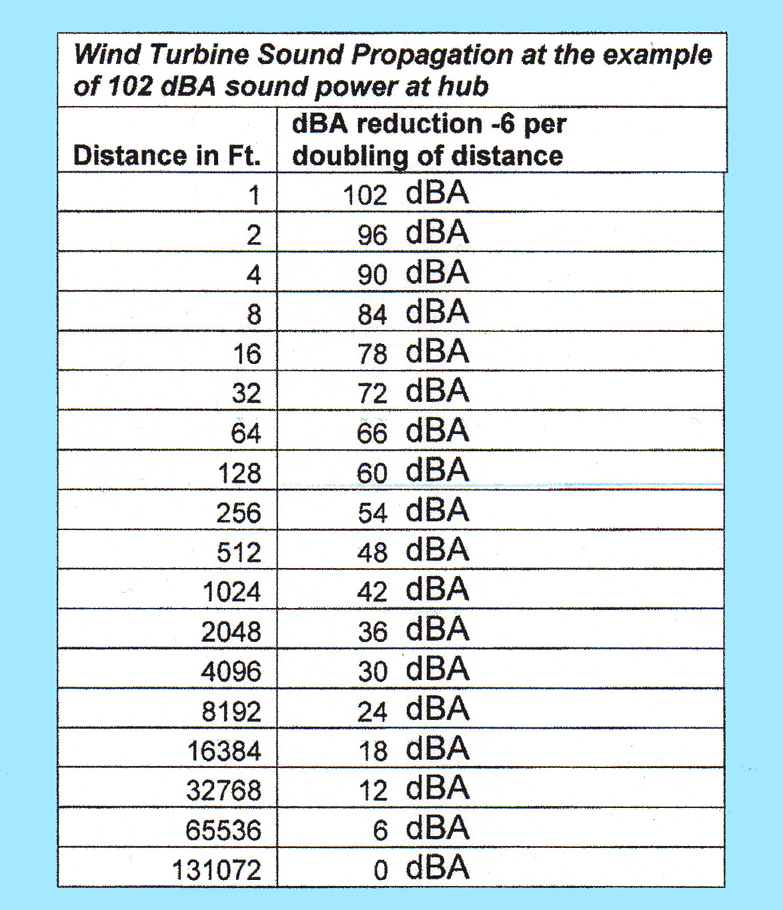
The closer people live to wind turbines, the more likely they will experience noise annoyance or develop adverse health effects from wind turbine noise.
The degree of difficulties resulting from the sound of wind turbines seems clearly related to the distance from the turbines.
A setback of 2640 feet from dwellings would eliminate most noise complaints.
Research conducted by Christopher Bajdek show that at approximately half a mile (0.8km) from wind turbines, 44% of the population would be considered highly annoyed from wind turbine noise. At a distance of a mile (1.62 km) from wind turbines, the percent of highly annoyed people is expected to drop to 4%. [click here for source]
George Kamperman and Richard James reviewed several studies to determine the impact of wind turbine noise on nearby residents.
Their review showed that some residents living as far as two miles complained of sleep disturbance from the wind turbine noise and many residents living 1000 feet from wind turbines experienced major sleep disruption and other health problems from nighttime wind turbine noise.
G.P. Van den Berg studied a wind farm in northwestern Germany and discovered that residents living 1640 feet (500m) from wind turbines reacted strongly to wind turbine noise and residents up to 1.18 miles (1900m) distance expressed annoyance. (Click here for source)
A survey conducted by Pederson and Waye revealed that less than 10% of the respondents experienced sleep disturbance at distances of 1,984 feet to 3,325 feet and found that sound from the wind turbines was of greater concern in rural environments because of the lower ambient [background] noise. (click here for source) (p. 10, 4.)
Eye-witnesses from the Town of Byron, Fond du Lac County, who testified at the public hearing held by the Town of Union Plan Commission live 1,100 feet to 3/4 of a mile from large wind turbines and they currently experience adverse health effects from wind turbine noise such as insomnia, headaches, nausea and dizziness. (click here to see Gerry Meyer's daily noise log) (p.10,5.)
Documents reviewed by the study committee recommend wind turbines should be located between half a mile to over a mile from dwellings.
To avoid adverse noise impacts, the Western Australia Planning Commission Bulletin recommends that wind energy systems include sufficient buffers or setbacks to dwellings of 1 km (.62 mile)
The National Wind Collaborating committee stated that an appropriate setback distance may be up to half a mile.
The National Research Council stated noise produced by wind turbines generally is not a major concern for humans beyond 1/2 mile or so because various meaures to reduce noise have been implemented in the design of modern turbines. (source)
The Wisconsin towns of Woodville, Clay Banks, Magnolia, Wilton and Ridgeville recently adopted large wind turbine ordinances with setbacks of 1/2 mile from dwellings. (click here to download these ordinances)
The French National Academy of Medicine and the UK Noise Association suggest a 1.5 km (approximately 1 mile) distance between large wind turbines and dwellings.
Dr. Amanda Harry, Dr. Nina Pierpont, and Frey and Hadden recommend a setback greater than 1 mile. (Harry) (Pierpont) (Frey and Hadden) (p.10-11, 6.)
Adverse health effects from wind turbine noise can be made more severe by the rotating blades and shadows from the wind turbines. As wind turbines rotate in sunny conditions, they cast strobelike-shadows on the windows of nearby homes and buildings, causing shadow flicker that cannot be avoide by occupants.
Shadow flicker can cause some people to become dizzy, nauseated, or lose their balance when they see the movement of the shadow.
Shadow flicker from wind turbines at greater than 3Hz poses a potential risk of inducing photosensitive seizures.
Therefore, wind turbines should be sited such that shadows from wind turbine blades do not fall upon the windows of nearby dwellings or within 100 feet of dwellings for any considerable period.
The Wind Energy Handbook recommends a setback of 10 rotor diameters to avoid shadow flicker on occupied structures. (See Acoustic Ecology Institute special report 2008, Burton 2001, UK Noise association 6/2006, Grahm Harding 2008, and Dr. Nina Pierpont 3/2/2006 and 8/1/2006) (p.11,7.)
(Click on the image below to see what shadow flicker looks like. This video was recorded at several homes in Fond du Lac County in the fall of 2008. If your internet connection isn't fast enough to watch it, contact us and we'll send you a copy on DVD.)
If placed too close to the road, the movement of the wind turbine blades and resulting shadow flicker can distract drivers and lead to accidents. (National Research Council, 2007 report, p. 263) (p.11,8.)
Wind turbines have been known to throw ice and debris from the turbine blaes. According to Professor Terry Matilsky from the Department of Physics and Astronmy at Rutgers University, ice throws from large wind turbines can reach up to a distance of 1750 feet and blade throws can reach 2500 feet. (p.11,9.)
Click on the images below to watch videos of ice and snow build-up on wind turbine blades in Fond du Lac County, recorded in December of 2008 and January 2009.
NOTE FROM THE BPWI RESEARCH NERD: We'll continue our look at the Town of Union's ordinance in the coming days. Meanwhile, here is an article which ran on February 11 about a wind farm resident living with the misery of poorly sited turbines in Ontario.
“In our haste to capture wind, there is no voice heard for public health, and when it is heard, it’s routinely ridiculed,”
-Carmen Krogh, retired pharmacist and Ontario wind farm resident from the following article which appeared on February 11. 2009
Retired pharmacist speaks to Killaloe, Hagarty and Richards about the effects industrial wind turbines had on her health
by Heather Kendall in Barry's Bay This Week [source]
When Carmen Krogh talks about the health effects of wind turbines, she speaks from experience. She shared that experience with the councillors of Killaloe, Hagarty and Richards Township at last week's regular meeting.
Extra chairs had to be pulled out of storage to handle the large crowd that came to hear her presentation to council.
Krogh has been involved with health care for more than 40 years; she is a retired pharmacist; she was the director of pharmacy at Edmonton General Hospital; when she moved to Ontario, she set up the drug information pharmacy at Ottawa General Hospital, where she researched drug therapies and advised doctors.
For 15 years, she was the director of publications and editor-in-chief of the Compendium of Pharmaceuticals and Specialties (CPS); she was an acting director for Health Canada's Pesticides Agency and has sat on numerous boards and committees dedicated to health.
She has also lived near wind turbines.
Her symptoms came on quickly, she said. She experienced bad headaches, dizziness, queasiness, a heart rhythm sensation and a vibration inside her body. Her health improved when she and her husband, who was not affected, left the area.
She decided to research the issue.
The Canadian Wind Energy Association says there is no evidence that turbines adversely affect human health, Krogh stated, but emerging research to the contrary is building momentum.
In 2006, the National Academy of Medicine in France recommended an epidemiology study be done.
Epidemiology, Krogh said, is the "holy grail for public health research. It investigates adverse effects in public health and gives doctors guidance on what could be a health risk and what to do about it. It's something the medical community depends on."
Krogh referred to a study of 10 families conducted by Dr. Nina Pierpont, whose book about wind turbines and health effects is soon to be released.
She studied the families before the turbines were erected and after their installation; nine of the families have moved away permanently and the other would like to but cannot afford to move.
Dr. Pierpont also recommended an epidemiology study be conducted.
The Wind Energy Association disagrees with Dr. Pierpont's findings, and raised questions about the scientific validity of her research (even though her book has not yet been released), Krogh said.
Krogh also brought up the findings of Dr. Robert McMurtry, who originally wanted to host a set of wind turbines on his property. After researching them, he too became concerned about the effects on human health.
In November of 2008 he did a deputation to Prince Edward County and suggested the county shouldn't proceed in development until authoritative guidelines are in place - guidelines based on epidemiology specifically targeting health effects.
One mayor in the county stated it didn't mean the county was against wind energy, but it would give council time to get answers to the questions that citizens should be asking.
"We're the citizens and we should be asking questions," said Krogh.
She went on to list the core symptoms people have reported: headaches, unsteady balance, nausea, sleep problems, anxiety, irritability, depression, problems with concentration and memory. Trouble with sleep is very serious, she added.
"Sleep deprivation can lead to serious medical problems," Krogh said. "According to Amnesty International, it is a tool for torture, so it's not trivial."
Though the health issues are not limited to one group, pre-existing health conditions can be made worse by the turbines; for example, more frequent and severe migraine attacks can be triggered; balance can be affected by the visual disturbance of moving blades or shadows of the blades on the ground.
Some people are affected quickly and others don't develop symptoms for two or three months.
The cause of the effects is low-frequency noise, which, Krogh said, affects the body's neurological system.
There are two types of noise from the turbines, she said: what you hear, which is measured in decibels, and low-frequency noise that you can't hear.
She referred to one study, which concluded low-frequency noise up to three kilometres away can cause sleep disturbance, and, from 300 metres away, can cause sleep disruption and serious medical problems.
A 27-year study found exposure to low-frequency noise causes the cells in the body to undergo pathological changes. A three-year study added to the long one concluded that turbines in residential areas produced an acoustic environment that can lead to Vibroacoustic Disease.
Krogh said the Ministry of the Environment does not measure for low-frequency noise; its guidelines are based on decibels.
"In our haste to capture wind, there is no voice heard for public health, and when it is heard, it's routinely ridiculed," said Krogh.
As studies progress, the distance for setbacks of the turbines grows. The general setback for the turbines now is greater than 250 metres; more and more researchers say that distance should be 1.5 to 3.5 kilometres.
Krogh gave examples of "victims" of the wind turbines. One was a healthy Shelburne woman who had 11 turbines west and east of her home. Both she and her husband developed health problems - even their dog was adversely affected.
"They believed the government, they believed the wind companies," said Krogh. "Everyone said, ‘Don't worry, we're not going to make the same mistakes as in Europe,' but these people are suffering."
She talked of the HIV blood scandal of the 1980s, where mounting evidence about tainted blood was ignored for a long time.
"Public health scandals happen and I'm almost on the verge of saying the wind issue will be one," Krogh said.
More researchers are calling for an epidemiology study.
"They're not saying stop this; they're saying let's harness the wind responsibly and make sure we get this right about where to put (the turbines) and how far away from people," she said.
"In the meantime, we should invoke the precautionary principle."
Krogh has started a letter-writing campaign and said now is the time to voice concerns to federal, provincial and municipal governments. She urged everyone to send out letters as well.
"Maybe it needs a groundswell from the public as a whole to say that we need to look into this further," she said.
Krogh commended council for passing the resolution urging the Province of Ontario to place a moratorium on wind farms until the effects are better understood.
"I think you did a very good job with your resolution," she said. "It raises the concern higher up. It's important municipalities express concern. It's about the politics now."
Click here to compare what this to what a Wisconsin resident has to say about living in a poorly sited wind farm.
Click here to compare it to what an Illinois wind farm resident has to say.
Click here to compare it to what a Maine wind farm resident has to say.
And click on the image below to hear what wind turbine noise sounds like at 1100 feet from a house. This video was recorded from the front of Larry Wunsch's home near the town of Byron, in Fond du Lac County. (if your internet connection is too slow to view the video, click here to contact us, and we'll send you a DVD)






